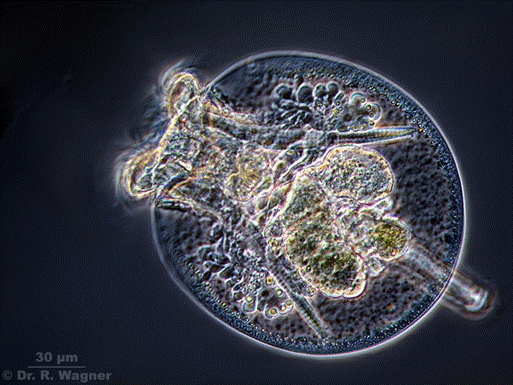|
|
Site created
by: Baihleigh Talon Testudinella sp.
|
||||||||||||||||||||||||||||||||||||||||||||||||||
|
Taxonomy Kingdom: Animalia Superphylum: Platyzoa Subclass: Monogononta
Superorder: Gnesiotrocha Order: Flosculariaceae
Family:
Testudinellidae Genus: Testudinella
|
Figure 1: Testudinella sp. Collected from Memorial Pond, 2004. |
Full Known Species List
|
|||||||||||||||||||||||||||||||||||||||||||||||||
|
Classification
Anatomy Most Testudinella are
characterized by a round, nearly completely circular shaped body. Individuals are capable of retracting both their
ciliated head and foot into their loricae. Testudinella have
two eye spots and distinctive visible musculature. The lorica is
unique in Testudinella in that its ventral and
dorsal plates are completely fused laterally (Glime
2013). Species differ in morphology
mostly in the shape of the lorica, which varies in
oval, vase-like, and circular forms.
Some species, however, also differ in the length of their foot, which
can be particularly longer or shorter than others. General Body Plan
Unlike all other types of rotifers, the foot of Testudinella contains cilia at its end. Figure 2: Testudinella incis,
Pond Collection from Hattingen Felderbachtal,
Germany, 2014.
Trophic Structures
Differences in Body Shape
Between Species
Distribution Species of Testudinella can be
found worldwide. Most inhabit
freshwater lakes and ponds, but eleven species have been isolated in salt
water environments. Five of these
species live exclusively in haline environments,
inhabiting marine and brackish waters.
The remaining species are haloxenous or euryhaline. Testudinella are known to inhabit the benthic, periphytic, and interstitial areas of the water column
(Wei et. al. 2010). Some species are
free-swimming in the littoral zone, where sunlight can reach the sediment
through the water, and where plant life is abundant. They can also be found in sphagnum pools
and among aquatic plants (Glime 2013). Testudinella
patina,
illustrated in Figure 10 above, has been located among arctic mosses in the
Antarctic ocean (Glime 2013). Interestingly, Testudinella patina can also be found in Lake
Erie, of the Great Lakes (GLERL 2015).
Like some species, T. patina has a tolerance for a wide
array of salt levels in its environment (Wei et al. 2010). Feeding Testudinella feed primarily on algae,
bacteria, and debris, using their ciliated corona to pull particles into
their mouths (GLERL 2015). Sometimes Testudinella will sit still, waiting for particles to
pass by, other times they will actively chase after particles, usually in a
spinning movement. The videos below
illustrate their feeding processes. Reproduction As members of the family Monogonata,
most individuals in a population are diploid females, reproducing through
parthenogenesis. Under the influence
of certain stimuli in the environment (possibly overcrowding, poor water
conditions, or food depletion), females will produce females which themselves
produce haploid eggs. These become
males if unfertilized. If fertilized,
however, a diploid, resting egg will be produced. These can remain dormant for some time
until conditions become acceptable again.
Resting eggs give rise to regular, diploid females. Males are significantly smaller than
females, and usually have a much reduced life-span, as their main purpose is
reproduction (GLERL 2015). |
|||||||||||||||||||||||||||||||||||||||||||||||||||
Works Cited:
Fontaneto, D., Melone, G. and De Smet,
W.H. (2008). Identification key to the genera of marine
rotifers worldwide. MEIOFAUNA MARINA Biodiversity,
morphology and
|
|||||||||||||||||||||||||||||||||||||||||||||||||||










